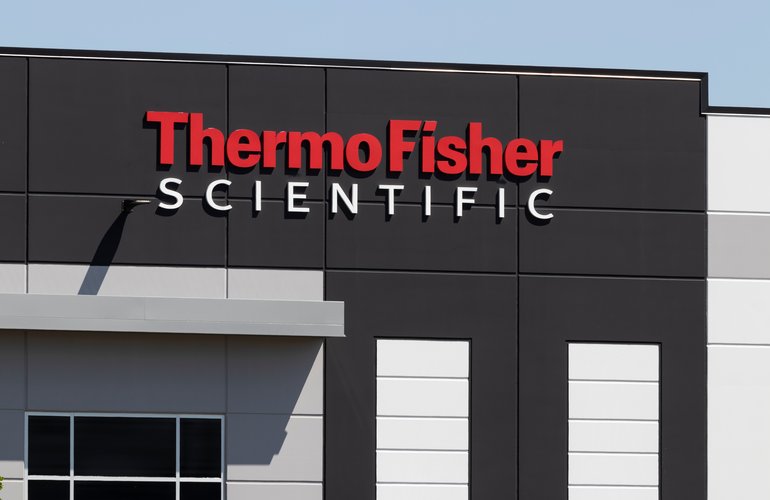[Adobe Stock]
Thermo Fisher Scientific beat Wall Street expectations in the third quarter of 2025, reporting $11.12 billion in revenue and adjusted earnings of $5.79 per share. The results signal resilience for lab infrastructure demand even as U.S. research budgets face headwinds and the U.S. government shutdown is in its 22nd day.
The Waltham, Mass.–based company’s Laboratory Products & Biopharma Services unit rose 4% to $5.97 billion, with momentum from pharma development and manufacturing; other segments also grew year over year, including Specialty Diagnostics ($1.17 billion) and Analytical Instruments ($1.89 billion). Management noted China remains a meaningful market at 8% of sales, even as policy uncertainty lingers. But the quarter also exposed persistent weakness: academic and government revenue declined in the low single digits, while the diagnostics and healthcare segment fell slightly owing to continued pricing pressure in China.
Academic and government customers facing pressures
During Wednesday’s earnings call, analysts pressed executives on how long the academic slowdown might last and whether pricing dynamics in China would improve. CEO Marc N. Casper acknowledged the uncertainty but pointed to the company’s operational flexibility and recent moves, including a collaboration with OpenAI and acquisitions in biopharma manufacturing, as offsets.
Casper said the results reflected “excellent operational performance” and raised full-year guidance to $44.1 billion to $44.5 billion in revenue, suggesting management expects pharma-led momentum to carry through year-end despite macro uncertainties.
During the Q&A session, analysts pressed for clarity on how shifting policy dynamics, from tariff de-escalation with pharma to reshoring incentives, might translate into concrete demand. Michael Ryskin from Bank of America asked whether recent “de-escalation on some of the MFN and tariff concerns” had changed conversations with major customers about moving manufacturing back to the U.S. Casper acknowledged “quiet confidence” among pharma executives that they can navigate government policies, but cautioned that new facility build-outs wouldn’t drive significant revenue until 2027 or 2028.
CHART: Pharma recovery drives growth amid academic softness
Segment performance (Q2 vs Q3 2025)
More immediately, Casper said, demand is coming from customers shifting production volume to Thermo Fisher’s existing U.S. pharma services network—including a recently acquired Sanofi sterile fill-finish site in New Jersey. Whether outsourcing to contract manufacturers like Thermo Fisher would actually shield drugmakers from Trump’s threatened 100% tariffs on imported drugs remains unclear: the president’s September Truth Social post exempted companies building “their Pharmaceutical Manufacturing Plant in America,” language that analysts said could exclude firms relying solely on CDMO partnerships rather than building their own facilities. Analysts also questioned whether the 22-day government shutdown could derail a nascent recovery in academic and government spending, which declined in the low single digits during the quarter. Casper said customers “feel better” about the prospect of stable NIH funding but noted the shutdown “adds a little bit to customer hesitancy” and will delay some federal purchases in Q4.
Pharma-driven momentum
Thermo Fisher’s pharma-driven momentum mirrors a broader industry recovery. Danaher Corporation, a key competitor, reported Q3 sales of $6.05 billion, up 4.5% year-over-year, with its Biotechnology division rising 9% and beating analyst expectations. Both companies are benefiting from renewed biopharma R&D spending after a two-year slowdown, though both have faced headwinds in life sciences as biotech labs pulled back on spending earlier in 2025 when government stimulus faded and private funding tightened. The pharmaceutical lab equipment market, dominated by Thermo Fisher, Danaher, Agilent and Waters, is projected to grow from $11.5 billion in 2024 to $15.6 billion by 2031, in large part as a result of burgeoning drug development demand and manufacturing capacity expansion even as the biotech sector faces ongoing post-pandemic pressures.
In addition, Thermo Fisher’s raised full-year guidance of $44.1B-$44.5B in revenue implies Q4 sales of $11.0B-$11.4B, roughly flat to slightly up versus Q3’s $11.12B. That conservative outlook reflects management’s expectation that the government shutdown will dampen federal lab purchases and that China’s diagnostic pricing pressure will persist. The raised adjusted EPS guidance to $22.60-$22.86 (implying Q4 EPS of $5.02-$5.28), however, suggests strong margin execution will continue, even if top-line growth moderates. The company’s decision to boost buybacks, having repurchased $1 billion in Q3 alone, signals confidence that current headwinds are temporary rather than structural.
Read the full article from the Source




